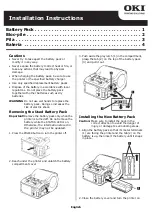
3
PRECAUTIONS FOR OPERATION
• Ensure the correct battery type has been selected before charging begins.
• Before connecting or disconnecting the SBC to a battery, ensure that it is disconnected
from the 240VAC supply.
• NOTE disconnecting the battery from the vehicle will cause some components in the
vehicle to lose stored memory or information, such as time on your stereo.
• Ensure electrolyte levels in the battery to be charged are suffi cient to cover the plates
(if accessible).
• DO NOT use the charger to charge a battery near a naked fl ame. The gasses emitted by
the battery whilst charging may ignite, causing a life threatening fi re or explosion.
• Always wear eye protection if working close to a charging battery.
• Take care whilst handling a lead acid battery, as the electrolyte is acidic and may cause
permanent damage to skin or clothing.
• The charger is designed to be used indoors and to be protected from the elements. Do
not expose the battery charger to the weather, particularly rain or dampness.
• Provide adequate ventilation whilst charging lead-acid batteries. This will ensure the
charger will work at maximum effi ciency and that any gasses emitted from the battery
are safely dissipated.
• Do not extend the output cables supplied between the charger and the battery to be
charged, otherwise effi ciency of operation will be compromised. Ensure the output
clamps are fi rmly attached to the battery poles.
• Incorrectly connecting the Positive (+ Red wire) and Negative (- Black wire) at the bat-
tery will switch off the battery charger to protect it’s internal electronics. Output and
consequent charging will only recommence when the (+) and (-) are correctly attached
to the corresponding (+) and (-) poles on the battery.
• Do not obstruct the fan. Note that the fan will run continuously during the charging
cycle.
• If the power cord is damaged, it must be replaced by the manufacturer or its service
agent or a similarly qualifi ed person in order to avoid hazard.
• The charger is designed to charge batteries constructed with 6 cells only.
• For in-vehicle charging,
1. The battery charger must be connected fi rst to the battery terminal which is not
connected to the vehicle chassis. The other connection is to be made to the
chassis, remote from the battery and fuel line. The battery charger is then to be
connected to the supply mains.
2. After charging, disconnect the battery charger from supply mains. Then remove
the chassis connection and the battery connection, in this order.
8






























